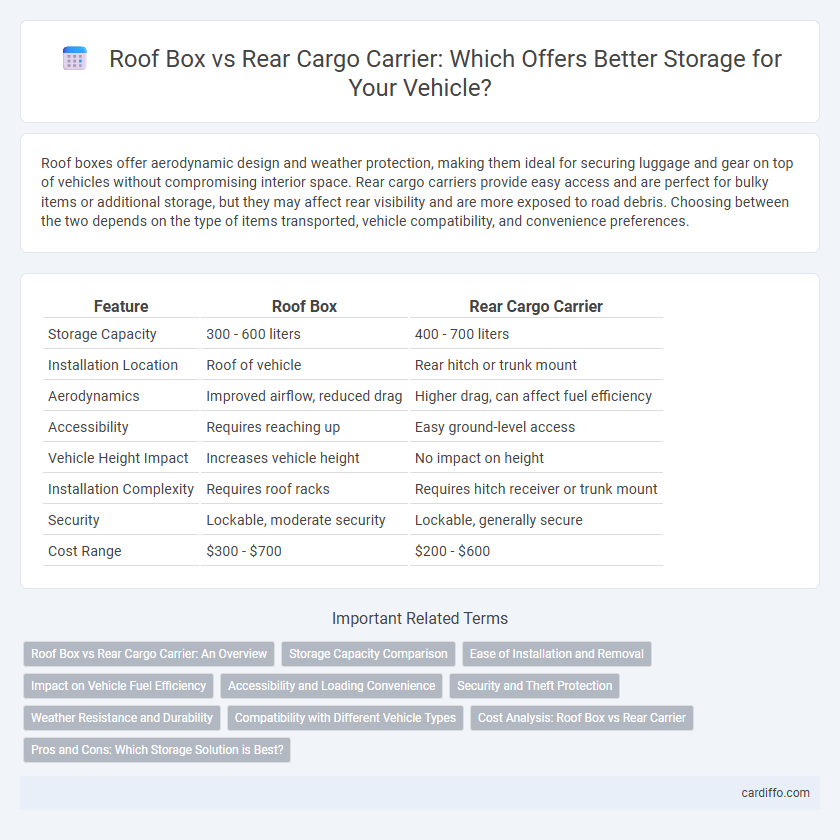Roof boxes offer aerodynamic design and weather protection, making them ideal for securing luggage and gear on top of vehicles without compromising interior space. Rear cargo carriers provide easy access and are perfect for bulky items or additional storage, but they may affect rear visibility and are more exposed to road debris. Choosing between the two depends on the type of items transported, vehicle compatibility, and convenience preferences.
Table of Comparison
| Feature | Roof Box | Rear Cargo Carrier |
|---|---|---|
| Storage Capacity | 300 - 600 liters | 400 - 700 liters |
| Installation Location | Roof of vehicle | Rear hitch or trunk mount |
| Aerodynamics | Improved airflow, reduced drag | Higher drag, can affect fuel efficiency |
| Accessibility | Requires reaching up | Easy ground-level access |
| Vehicle Height Impact | Increases vehicle height | No impact on height |
| Installation Complexity | Requires roof racks | Requires hitch receiver or trunk mount |
| Security | Lockable, moderate security | Lockable, generally secure |
| Cost Range | $300 - $700 | $200 - $600 |
Roof Box vs Rear Cargo Carrier: An Overview
Roof boxes offer aerodynamic designs that minimize wind resistance while providing secure, weatherproof storage ideal for camping gear and sports equipment. Rear cargo carriers mount on the vehicle's hitch, delivering easy access and increased capacity but may reduce rear visibility and affect fuel efficiency. Choosing between a roof box and rear cargo carrier depends on vehicle type, storage needs, and preferred loading convenience.
Storage Capacity Comparison
Roof boxes typically offer storage capacities ranging from 10 to 22 cubic feet, making them ideal for bulky items while maintaining vehicle aerodynamics. Rear cargo carriers can provide similar or larger storage volumes, often exceeding 20 cubic feet, but may limit rear hatch access and affect fuel efficiency. Choosing between the two depends on the specific storage needs and vehicle compatibility.
Ease of Installation and Removal
Roof boxes typically require mounting on roof rails with U-bolts or clamps, which can take 10 to 20 minutes depending on experience and equipment. Rear cargo carriers generally attach to the hitch receiver via a simple latch or pin system, allowing for faster installation often under 10 minutes. Removing rear cargo carriers is usually easier since they don't need roof rail adjustments, making them convenient for frequent installation and removal.
Impact on Vehicle Fuel Efficiency
Roof boxes increase aerodynamic drag, often reducing fuel efficiency by 10-25%, especially at highway speeds due to added wind resistance. Rear cargo carriers create less drag but can increase weight and affect rear airflow, leading to a smaller fuel penalty of around 5-15%. Choosing a rear cargo carrier is generally more fuel-efficient than a roof box for extended travel.
Accessibility and Loading Convenience
Roof boxes offer elevated storage that keeps items secure and weather-protected but require lifting heavy gear overhead, which may be challenging for some users. Rear cargo carriers position storage at vehicle height, simplifying loading and unloading while allowing easier access during trips. Choosing between the two depends on vehicle type, user strength, and frequency of access needed for stored items.
Security and Theft Protection
Roof boxes offer enhanced security with lockable designs that deter theft and protect belongings from weather damage. Rear cargo carriers typically provide less robust locking mechanisms and are more exposed, increasing vulnerability to theft. Choosing a lock-equipped roof box significantly improves theft protection for valuable items during travel.
Weather Resistance and Durability
Roof boxes are typically made from high-density polyethylene or ABS plastic, offering superior weather resistance against rain, snow, and UV rays, making them highly durable for long-term outdoor use. Rear cargo carriers, usually constructed from metal frames with fabric containers, provide moderate weather protection but may be more susceptible to water seepage and wear over time. The hard shell design of roof boxes often ensures better impact resistance and longevity compared to the more flexible and exposed rear cargo carriers.
Compatibility with Different Vehicle Types
Roof boxes offer broad compatibility with most vehicles equipped with roof racks, including SUVs, sedans, and hatchbacks, providing versatile storage without limiting rear access. Rear cargo carriers are ideal for vehicles with a hitch receiver, commonly SUVs, trucks, and some crossovers, but they may reduce rear hatch accessibility and are less suitable for sedans. Choosing between roof boxes and rear cargo carriers depends on vehicle type, roof rack presence, and hitch availability to maximize storage efficiency and convenience.
Cost Analysis: Roof Box vs Rear Carrier
Roof boxes generally incur higher upfront costs, averaging $400 to $800, compared to rear cargo carriers, which range from $200 to $500. Installation expenses and vehicle compatibility often make rear carriers more budget-friendly, especially for frequent users or those with SUVs and trucks. Long-term value also depends on storage capacity and durability, with roof boxes offering weatherproof protection at a premium price.
Pros and Cons: Which Storage Solution is Best?
Roof boxes offer streamlined, weather-resistant storage with aerodynamic designs that minimize impact on fuel efficiency, ideal for bulky or delicate items. Rear cargo carriers provide easier access and larger capacity but may obstruct rear visibility and increase drag, affecting vehicle handling and fuel consumption. Choosing between the two depends on specific storage needs, vehicle type, and priorities like convenience, security, and aerodynamics.
Roof box vs rear cargo carrier Infographic

 cardiffo.com
cardiffo.com